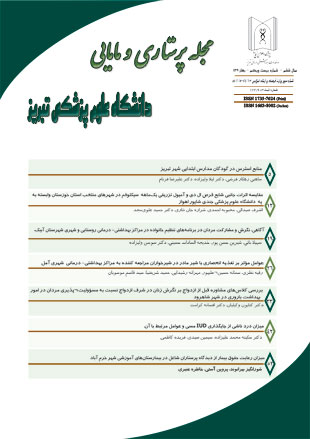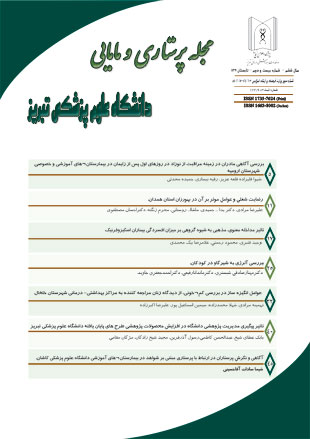فهرست مطالب

فصلنامه پرستاری و مامایی
پیاپی 21 (بهار 1390)
- تاریخ انتشار: 1390/10/11
- تعداد عناوین: 7
-
Page 5Background and ObjectivesSeveral studies in other countries have recognized many stress sources in children. Moreover, most of these studies have focused on significant and traumatic life event and haven’t paid enough attention to increasing stress and pressure in children’s daily life. Since there are about 5.5 million elementary students in our country, a study has been done aimed at investigation stress resources in school-age children to describe present status and to make it as a basis for future interventions.Materials and MethodsThis descriptive research has been done with participation of students, 3 to 5 grade in elementary schools of Tabriz, with the sample size of 300 participants, who first were randomly chosen from 5 education zones of Tabrize and then, sampling in school was done in the way of simple random. The data has been gathered using Children Stress Sources Scale questionnaire (CS), after content validity, translation and rehabilitee in the way of test re-test, through individual interview. Analyzing data has been done using SPSS software.ResultsAge average was 10.41±1.04. Children had reported all of 51 cases of stress source. Among 51 case of stress sources, 23 cases were the most common, which are respectively: anxiety about family members, thinking about parents and close people’s death, low grade, bad dreams, natural calamity, being late in doing homework, getting lost, exam, etc. Minor cases consisted of going to school, general problems in school and changing home and school.ConclusionThe study indicate this fact that different and various event can disturb children comfort which are usually out of adult’s attention. So, with due attention to the result of the study, it’s important to plan school-centered interventions or programs for decreasing common stresses which on reason for many physical and behavioral problems in school-age students.
-
Page 13Background and ObjectivesIn spite of the variety in contraceptive methods unwanted pregnancy is a threatening factor of mothers’ and children's health yet. Pay attention to the main role of the contraceptive methods of mother's and children’s health & society, this research has considered the comparison common side effects in two ways of contraceptive injection cyclofem and oral low dose.Materials and MethodsThis research has done is descriptive, married women in reproductive age, in two groups; contraceptive low dose with 95 subjects and injection cyclofem groups with 106 subject. Gathering information materials in this research were; the available documents in cases in clinics & interview & Fill out the questionnaire.ResultsThe breast tenderness was more in cyclofem group, but the difference wasnt significant (p>0/05), spotting between two menses with (p<0.001), bleeding between two menses with (p<0.001) and amenorrhea with (p<0.004) and it was more in cyclofem group and the difference was significant. But headache with (p<0.001) and nausea with (p<0.001) in contraceptive low dose was more, and a significant difference was observed between two groups.ConclusionBased on search finding Ld tablets have more side effects like headach and nausea, but appearing of spotting and bleeding between two menses in cyclofem group is more than Ld tablet group. In spite of that the appearing of side effects like headache and nausea is more less in cyclofem group, but the pattern of bleeding severly affects the use and capability of this method so that changes in bleeding pattern is an important reason for dissatisfaction of Client.
-
Page 22Background and ObjectivesApproximately more than half of country populations are men that considering the country’s cultural traditional structure, they have important role in decision making. Inexistence participation of men in family planning programs causes: failure of this programs, increase population growing and related problems. This study were done to compare knowledge, attitude and cooperation of men in family planning programs in rural and urban health centers.Materials and MethodsThis study is a descriptive-comparative study that was done by quota sampling on 400 married men living in Abeyek urban and rural centers. Research instruments was questionnaire including knowledge, attitude and cooperation sections that two parts related to knowledge and attitude were filled by men and cooperation part were completed with interview by women. Data were analyzed by descriptive statistics, Pierson test, independent T test, K square test and variance analyze test.ResultsThe results of this study showed that average score of knowledge in city was 7/40 +- 2/37 and in rural area was 6/84 +- 2/29. Comparing average of knowledge total score was showed significant difference(p= 0/017). also average score of attitude in city was 54/68 +- 6/12 and in rural centers was 2/24 +- 6/25, comparing this two averages was showed significant difference (p=0/005).In addition this study showed that total score of cooperation in city was 8+-2/57 and in rural centers was 7/70 +-2/47, there was no significant difference between these averages (p= 0/23).According to findings of this study there was significant relation between knowledge and cooperation (p=0/005, r=0/293) and between attitude and cooperation (p=0/005, r=0/328). Moreover in this study withdrawal method in city and using condom in rural centers were more common methods.ConclusionAlthough knowledge and attitude of men about family planning in city is a little more than rural centers, there is no significant difference between their cooperation in family planning in urban and rural centers. As knowledge and attitude are important factors influencing men’s cooperation rate, it seems that other factors can influence this cooperation that is worth to speculation and attention.
-
Page 32Background and ObjectivesThe real value of breast milk was known in health supplies and preserve life, But all of mothers are not successes to exclusive breast feeding for their children. This study aimed to assess Affective Factors to exclusive breast feeding in infants referred to health centers of Amole.Materials and MethodsIn this case - control study was assessed 198 children 6-12 mouths in the Amole. 98 infants have exclusive breastfeeding, is defined as no food or liquid other than breast milk, not even water, is given to the infant from birth until six months of age,(case group) and 100 infants haven’t exclusive breastfeeding(control group). Data were collected by interview and assess of family file. Data analyzed in SPSS16 by chai- square t-test and odds ratio.ResultsAverage age of case group mothers were 25.91±5.4 years and control group were 28.4±5.6 years (P<0.05). Literacy of 23 mothers (23.5%) of case group mothers and 30 mothers of control group were academic. 89 mothers (90.8%) of case group mothers and 86 mothers of control group were trained about breastfeeding. Type of delivery, maternal family history of breast feeding, use of pacifiers and contact mother and infant immediately at birth were different in both groups significantly (P <0 / 05). But maternal employment, birth rank, insists of mother's family, child sex, get training, desired sex of the child, were not different significant.ConclusionOur study showed that, high maternal age, cesarean section delivery and use of pacifiers reduce exclusive breastfeeding. History of breast-feeding in mother's family mother and immediate contact after birth, increases exclusive breast feeding. So it is necessary to reduce the negative effects and strengthening the positive influence factors to benefit more children from exclusive breast feeding.
-
Page 39Background and ObjectivesMarriage and establishing a family is one of the most important events of everyone's life, which is performed with knowledge, has significant personal and social effects on individuals. In recent years, premarital programs are considered important in order to promote the quality of married life. This study was carried out to determine attitude of women at the stage of marriage in Shahroud 1388.Materials and MethodsThis descriptive cross-sectional study was performed on 205 women referring to health centers in Shahroud during the years 2009. The data-gathering tool was a questionnaire containing 2 forms. The first form included demographic questions attitude questions were responsibility femals in 6 area including in fertility, family planning, sexual desease prevention (sexual health), household care, parenting and violence. Assessing was done pre and post counsultation marriage class. Descriptive statistics and analytic such as, χ2, willcoxon, were used for analyzing the data.ResultsMean age of the females under study was 22. 91±3. 856 years. Mean of women attitude from 69. 20±8. 284 (before counsult) to 72. 8±9. 6 after invention (P<0. 05).ConclusionRegarding data، it seems attitude should be improved in the field of reproductive health and specially emphasize on content and appropriate educational method in marriage class.
-
Page 47Background and ObjectivesThe copper bearing intrauterine device (IUD) is a long-term, reversible contraception method that is as effective as tubal sterilization. Its insertion pain or fear of it may make women hesitate to use an IUD. This study was performed to measure intensity of pain with Tcu380A IUD insertion and identify its related factors.Materials and MethodsThis study was done among 96 women who have IUD inserted at a health center with highest IUD insertion in Tabriz. One expert midwife inserted all the IUDs. Pain after IUD insertion was measured using 0-10 cm visual analogue scale. T-test, oneway ANOVA and linear regression were used to identify the related factors.ResultsThe mean pain score was 3.5±1.8. About half of the women reported moderate (pain intensity 4-6) or severe (≥7) pain (45.8% and 5.2% respectively). In univariate analysis, mean reported pain score was significantly higher among women with no history of vaginal delivery, no breastfeeding, more than 12 months interval from delivery and history of previous IUD insertion (P> 0.05). There was no relationship between age, educational level, history of abortion and parity with the pain (P> 0.05). In multivariate analysis, only no history of vaginal delivery (P= 0.002) and history of previous IUD insertion (P= 0.05) were related with increasing the reported pain.ConclusionIUD insertion is a painful procedure. Therefore, it is needed to counsel women about the pain before IUD insertion, especially in women with the risk factors. Research is recommended on pain relief methods during IUD insertion.
-
Page 53Background and ObjectivesPatients are among the most vulnerable social groups whose particular situation makes their rights more sensitive in health care system. They relegate themselves totally to the health care system and trust to the health professionals. In such a context, it seems necessary to provide tools and strategies for assuring patients rights advocacy. Hence study determines the respecting patient’s rights from nurses point of view employed.Materials and MethodsThis is a cross-sectional study which is done in order to This study carried out on 234 nurses was selected through available sampling. Data was collected via a questionnaire about demographic information and patient’s rights situations for measured level of respect, which is Analyzed via SPSS spices soft. Data were analyzed using descriptive statistics, one way ANOVA and t-test.ResultsThe result showed good respect for patient’s rights about 75% by nurses (66/46±9). The result indicated a meaningful different between respect for patient’s rights and kind of Hospital, word and job position.(p<0/03)ConclusionResults show that patient’s rights more than half 0f cases by nurse’s respect. But, it is necessary to do some measures’ such as: approval of laws related to patient’s and nurses rights and training health’s care in order to observe patients satisfaction and better qualified patient’s care.


